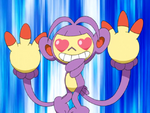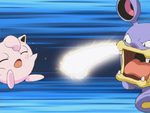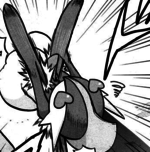Cute Charm (Ability): Difference between revisions
(→Outside of battle: expanding on what was written before - RNG manip isn't necessary for this to work. I could go into detail about why the PIDs form each shiny group, but it makes it too technical I think) |
ProtoMan1337 (talk | contribs) |
||
| (6 intermediate revisions by 5 users not shown) | |||
| Line 23: | Line 23: | ||
From {{game|Emerald}} onwards, if a Pokémon with Cute Charm is in the first place in the [[party]] (even if [[fainting|fainted]]), there is a 66.7% chance that the game will force an encountered Pokémon to be the opposite gender from the Pokémon with Cute Charm if it can be that gender. This does not affect a [[Pokémon outbreak|swarming]] Pokémon species or Pokémon found in [[Hidden Grotto]]s. | From {{game|Emerald}} onwards, if a Pokémon with Cute Charm is in the first place in the [[party]] (even if [[fainting|fainted]]), there is a 66.7% chance that the game will force an encountered Pokémon to be the opposite gender from the Pokémon with Cute Charm if it can be that gender. This does not affect a [[Pokémon outbreak|swarming]] Pokémon species or Pokémon found in [[Hidden Grotto]]s. | ||
====Effects on personality value==== | |||
In [[Generation IV]] only, when Cute Charm forces a Pokémon to be a specific gender, it does so by setting its [[personality value]] to one out of 25 possible values that correspond to the forced gender (one value per [[nature]]). The set of possible values depends on the gender of the Pokémon with Cute Charm, and if the Pokémon with Cute Charm is female, the wild Pokémon's [[gender ratio]]. This has significant consequences for properties determined by personality value. | |||
As a result, when the encountered species can be affected by Cute Charm (i.e., when it is not a male-only, female-only, or genderless species), the chances of encountering a [[Shiny Pokémon]] differ from the usual 1/8192, depending on how many of the 25 possible values forced by Cute Charm result in a [[Shiny Pokémon]] (in conjunction with the [[Trainer ID number]] and [[Secret ID]]): they may be as low as 1/24546 (if none of the 25 values forced by Cute Charm result in Shiny Pokémon, so the Pokémon can only be Shiny if Cute Charm fails), or as high as 21.34% (if 8 out of the 25 values forced by Cute Charm result in Shiny Pokémon). | |||
Additionally, {{p|Spinda}} whose gender has been forced by Cute Charm in Generation IV only have one of 50 patterns (25 for male, 25 for female). | |||
==Pokémon with Cute Charm== | ==Pokémon with Cute Charm== | ||
| Line 63: | Line 68: | ||
==In other languages== | ==In other languages== | ||
{{langtable|color={{fairy color}}|bordercolor={{fairy color dark}} | {{langtable|color={{fairy color}}|bordercolor={{fairy color dark}} | ||
|zh_yue=迷人之軀 | |zh_yue=迷人之軀 ''{{tt|Màihyàhn-jī Kēui|Enchanting Body}}'' {{tt|*|Games}}<br>迷人身軀 ''{{tt|Màihyàhn Sānkēui|Enchanting Body}}'' {{tt|*|Movie, DP National Pokédex guidebook}}<br>瞌睡 ''{{tt|Hahpseuih|Drowsy}}'' {{tt|*|RS National Pokédex guidebook}} | ||
|zh_cmn=迷人之軀 / 迷人之躯 ''{{tt|Mírén-zhī Qū|Enchanting Body}}'' {{tt|*|Games}}<br>迷人身軀 ''{{tt|Mírén Shēnqū|Enchanting Body}}'' {{tt|*|Anime, DP National Pokédex guidebook}}<br>瞌睡 ''{{tt|Kēshuì|Drowsy}}'' {{tt|*|Adventures (Ching-Win Publishing), RS National Pokédex guidebook}}<br>迷人的身体 ''{{tt|Mírén-de Shēntǐ|Enchanting Body}}''{{tt|*|Late Adventures (Jilin Publishing)}}<br>颓废的身体 ''{{tt|Tuífèi-de Shēntǐ|Intoxicated Body}}''{{tt|*|Early Adventures (Jilin Publishing)}} | |zh_cmn=迷人之軀 / 迷人之躯 ''{{tt|Mírén-zhī Qū|Enchanting Body}}'' {{tt|*|Games}}<br>迷人身軀 ''{{tt|Mírén Shēnqū|Enchanting Body}}'' {{tt|*|Anime, DP National Pokédex guidebook}}<br>瞌睡 ''{{tt|Kēshuì|Drowsy}}'' {{tt|*|Adventures (Ching-Win Publishing), RS National Pokédex guidebook}}<br>迷人的身体 ''{{tt|Mírén-de Shēntǐ|Enchanting Body}}''{{tt|*|Late Adventures (Jilin Publishing)}}<br>颓废的身体 ''{{tt|Tuífèi-de Shēntǐ|Intoxicated Body}}''{{tt|*|Early Adventures (Jilin Publishing)}} | ||
|nl=Warme charme | |nl=Warme charme | ||
Revision as of 14:39, 18 January 2018
| Cute Charm | メロメロボディ | ||||||||||||||||||||||||||||||||||||||||
| Mad Love Body | |||||||||||||||||||||||||||||||||||||||||
Flavor text
| |||||||||||||||||||||||||||||||||||||||||
Cute Charm (Japanese: メロメロボディ Mad Love Body) is an Ability introduced in Generation III.
Effect
In battle
When a Pokémon with this Ability is hit by a move that makes contact, there is a 30% chance that the attacking Pokémon will become infatuated if it is of the opposite gender to the Pokémon with this Ability. This Ability will not activate if the Pokémon with this Ability is genderless.
If a Pokémon with this Ability is hit by a multi-strike move that makes contact (such as Fury Swipes), each hit has an independent chance to activate this Ability.
Outside of battle
From Pokémon Emerald onwards, if a Pokémon with Cute Charm is in the first place in the party (even if fainted), there is a 66.7% chance that the game will force an encountered Pokémon to be the opposite gender from the Pokémon with Cute Charm if it can be that gender. This does not affect a swarming Pokémon species or Pokémon found in Hidden Grottos.
Effects on personality value
In Generation IV only, when Cute Charm forces a Pokémon to be a specific gender, it does so by setting its personality value to one out of 25 possible values that correspond to the forced gender (one value per nature). The set of possible values depends on the gender of the Pokémon with Cute Charm, and if the Pokémon with Cute Charm is female, the wild Pokémon's gender ratio. This has significant consequences for properties determined by personality value.
As a result, when the encountered species can be affected by Cute Charm (i.e., when it is not a male-only, female-only, or genderless species), the chances of encountering a Shiny Pokémon differ from the usual 1/8192, depending on how many of the 25 possible values forced by Cute Charm result in a Shiny Pokémon (in conjunction with the Trainer ID number and Secret ID): they may be as low as 1/24546 (if none of the 25 values forced by Cute Charm result in Shiny Pokémon, so the Pokémon can only be Shiny if Cute Charm fails), or as high as 21.34% (if 8 out of the 25 values forced by Cute Charm result in Shiny Pokémon).
Additionally, Spinda whose gender has been forced by Cute Charm in Generation IV only have one of 50 patterns (25 for male, 25 for female).
Pokémon with Cute Charm
| # | Pokémon | Types | First Ability | Second Ability | Hidden Ability | ||
|---|---|---|---|---|---|---|---|
| 0035 | 
|
Clefairy |
Fairy | Cute Charm | Magic Guard | Friend Guard | |
| 0036 | 
|
Clefable |
Fairy | Cute Charm | Magic Guard | Unaware | |
| 0039 | 
|
Jigglypuff |
Normal | Fairy | Cute Charm | Competitive | Friend Guard |
| 0040 | 
|
Wigglytuff |
Normal | Fairy | Cute Charm | Competitive | Frisk |
| 0173 | 
|
Cleffa |
Fairy | Cute Charm | Magic Guard | Friend Guard | |
| 0174 | 
|
Igglybuff |
Normal | Fairy | Cute Charm | Competitive | Friend Guard |
| 0300 | 
|
Skitty |
Normal | Cute Charm | Normalize | Wonder Skin | |
| 0301 | 
|
Delcatty |
Normal | Cute Charm | Normalize | Wonder Skin | |
| 0350 | 
|
Milotic |
Water | Marvel Scale | Competitive | Cute Charm | |
| 0428 | 
|
Lopunny |
Normal | Cute Charm | Klutz | Limber | |
| 0572 | 
|
Minccino |
Normal | Cute Charm | Technician | Skill Link | |
| 0573 | 
|
Cinccino |
Normal | Cute Charm | Technician | Skill Link | |
| 0700 | 
|
Sylveon |
Fairy | Cute Charm | None | Pixilate | |
| 0759 | 
|
Stufful |
Normal | Fighting | Fluffy | Klutz | Cute Charm |
Please note that abilities marked with a superscript are only available in the stated generation or later.
| |||||||
In the anime
| The opponent becomes mesmerized when it directly hits the Pokémon with an attack. | |||
| Pokémon | Method | ||
|---|---|---|---|
| User | First Used In | Notes | |

|
The opponent falls in love when it directly hits Jigglypuff with an attack and it is of the opposite gender of Jigglypuff. While in love, the opponent's eyes become replaced with hearts. | ||
| Lisa Mitchum's Jigglypuff | Rough, Tough Jigglypuff | Debut | |

|
When Delcatty gets hit by a physical attack and the opponent is of the opposite gender, the opponent falls in love with Delcatty. While in love, its eyes are replaced with hearts. | ||
| Lila's Delcatty | Battling the Generation Gap! | None | |
In the manga
In the Pokémon Adventures manga
| The opponent falls in love with the Pokémon when they make contact with each other. | |||
| Pokémon | Method | ||
|---|---|---|---|
| User | First Chapter Used In | Notes | |

|
Sometimes when Skitty makes contact with the opponent while the opponent is of the opposite gender of Skitty, it falls in love with it. While in love, its eyes are replaced with hearts. | ||
| Ruby's Kiki | Stick This in Your Craw, Crawdaunt II | Debut | |

|
Sometimes when Lopunny makes contact with the opponent while the opponent is of the opposite gender of Lopunny, it falls in love with it, making it hard for it to attack female Pokémon. While it is in love, its eyes are replaced with hearts and it drools slightly. | ||
| Platinum's Lopunny | Getting the Drop on Gallade II | None | |
- In volume 24, Green's Jiggly and Clefy were each revealed to have Cute Charm as their Ability.
- In the Japan Mini-volume 6 for the X & Y arc, Y's Veevee was revealed to have Cute Charm as her Ability.
In other languages
| ||||||||||||||||||||||||||||||||||||||||||||
| Variations of the Ability Cute Charm | |
|---|---|
| Cute Charm • Effect Spore • Flame Body • Poison Point • Static | |

|
This article is part of Project Moves and Abilities, a Bulbapedia project that aims to write comprehensive articles on two related aspects of the Pokémon games. |




